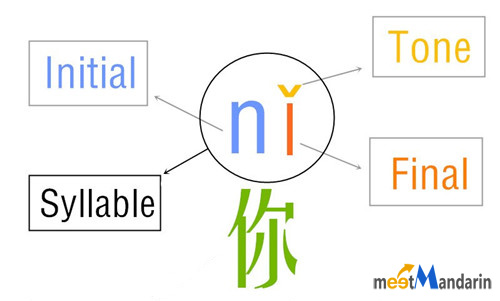Chinese Pronunciation Guide for Beginners
If you've just started learning Mandarin Chinese, you need to put a lot of effort into learning Chinese pronunciation. Being able to pronounce Mandarin correctly will help you in both speaking and listening.
The Chinese pronunciation system is known as Pinyin, adopted as a system for representing Chinese characters. Pinyin is very commonly used in Chinese people's daily life. For example, most people use Pinyin to enter characters into their computers or mobile phones.
What is Pinyin Like?
In Chinese, a syllable (pinyin) is composed of a consonant, a vowel and a tone. A Chinese syllable usually begins with a consonant which is called Initial, and is followed by vowel(s) which are called Final(s).

Pinyin for Chinese Character "你" (you).
Initials
Even though all of the consonants in Chinese represent basically the same sound that they have in English, it is important that you pay close attention to how each letter of pinyin is pronounced, as you can not read pinyin as if it were English.
Finals
In addition to the simple finals above, there are compound finals: ia, iao, ian, iang, iong, ua, uo, uai, uan, uang, ueng, üe, ün, üan. We can simply regard a compound final as a combination of the simple ones. For example, "ia" is made from "i" and "a". "iao" is made from "i" and "ao". To pronounce a compound final, read the simple finals separately and make a smooth slide of the sound.
Tones
1st Tone
The first tone is high and flat. It also sounds a bit longer in duration compared to the other three tones.
2nd Tone
The second tone is rising. To many learners, it sounds like you're asking a question.
3rd Tone
The third tone is a "falling-rising" tone. The key to speak it correctly is to keep the sound very low before it rises.
4th Tone
The fourth tone is known as the “angry” tone, because it is falling and tends to be shorter in duration than the other three tones.
Mandarin is normally said to have just four tones. However, there is also a neutral tone which occurs very often in spoken Chinese. The neutral tone, which is indicated by an absence of the tone mark is pronounced soft and short.
When the tone changes, the meaning of the word may change too. Actually there are a lot of homophones whose meaning varies with the tone. For example, the following four characters have exactly the same pinyin letters, but with different tones. Their meanings vary a lot from each other.

Position of Tone Marks
Tone marks in Hanyu Pinyin always go over vowels, not consonants. Usually, the alphabetical order dictates which letter gets the tone mark. For example, in “qiāo”, “a” comes earlier than all the rest letters, so we place the mark over it.
There is one exception: iu. In this case, “u” gets the mark even though it’s after “i” in the alphabet.
Erhua, the "r" Sound
"Erhua" refers to the addition of a final "r" sound to a syllable in mandarin Chinese. In written Chinese, "Erhua" is represented by the letter “r” added to the end of the final. E.g.
As a habit of pronunciation, the "r" sound is especially common in the Beijing dialect, but is a feature of standard Chinese as well. People from north of China, especially Beijingers tend to add the “r” sound to certain words. However, unless you know that a particular word is used in this manner, do NOT indiscriminately add an ending “r” to sound more native.
Rules of Spelling
The general rule is: the initials and finals are grouped together with a tone. However, there are some special situations.
1. When initials "j q x y" meet "ü", the two dots above "ü" are omitted.
2. When there is no initial before finals with "i" or "u", "i" should be changed into "y", and "u" into "w".
3. When "ui, un, iu, ü" stand alone, they become:
Resources and Tools
Pinyin Chart
Our Pinyin chart with audios includes all Mandarin Chinese syllables. Click on any pinyin sound in the chart, and listen to the audio in all four tones!
Chinese to Pinyin Converter
Covert Chinese characters (simplified or traditional) to pinyin with tone marks.
Mandarin Pronunciation Youtube
XiaoQian's 7 days for Mandarin pronunciation guide on youtube is an awesome resource to learn Chinese pinyin.
Rules for Tone Change
There are three main tone change rules that every learner needs to know. These rules are not normally reflected in the tone marks of pinyin. You just have to know them.